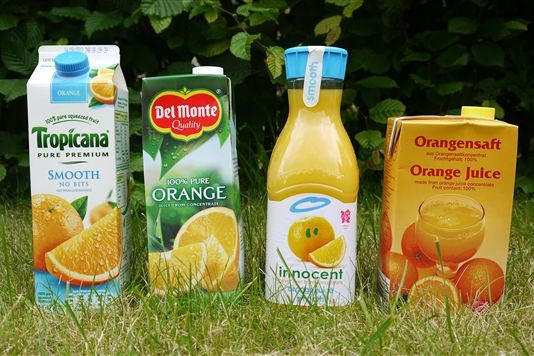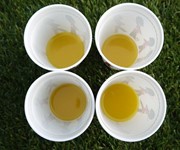Basic Britain: orange juice

What is breakfast without freshly squeezed orange juice? But when it takes three or four oranges to create a glass, it's much more affordable to buy it from the supermarket. Laura Rowe takes a closer look at Britain's favourite thirst quencher.
As far as I am concerned, the future’s always been orange. My weekend hangover isn’t complete without a glass of orange juice, but my shopping habits have changed over the past 10 years. When I first broke free of the nest, I was all for the cheap-as-chips concentrate carton. But ever since I finished university, I felt the need to upgrade with some foodstuffs – and orange juice was one of them. But how do the budget ranges stand up to the brands? Here’s a comparison of some of the popular brands of orange juice in the UK: Del Monte 100% Pure Orange Juice From Concentrate £1.58/litre; Tropicana Pure Premium Smooth £2.28/litre; Innocent Orange Juice Smooth £2.18/900ml; and Lidl’s budget version, simply Orange Juice 56p/litre.
Is fresh best?
 According to the brilliant What to Eat? by Hattie Ellis, the practice of drinking orange juice in the UK dates back to the 17th century, when taking a glass was first recorded by diarist Samuel Pepys back in 1669. Since then we’ve gone from the simple art of squeezing the fruit to concentrating, freezing and pasteurising. Of course, you could squeeze your own oranges, but each one costs in the region of 30p and when you need three or four to make a decent glass of juice at home, that’s an economy only few can enjoy on a regular basis. So, to the readymade rescue... I began by doing a quick blind-tasting. The juices fall into two camps on appearance. Light and dark – the former turning out to be Tropicana and Innocent; the latter Lidl and Del Monte (both of which are made with concentrate). When it comes to taste Innocent comes top. We felt it was the closest you were going to get to fresh. It had a nice balance of sweet and sour and felt light in the mouth. Tropicana was quite sweet and thin, but good – one taste tester felt it “tasted of Florida”. Lidl came third, but was the most acidic, while Del Monte was fourth and had a slight aftertaste. There was a general consensus that all of the juices were a pretty good standby alternative to the real thing.
According to the brilliant What to Eat? by Hattie Ellis, the practice of drinking orange juice in the UK dates back to the 17th century, when taking a glass was first recorded by diarist Samuel Pepys back in 1669. Since then we’ve gone from the simple art of squeezing the fruit to concentrating, freezing and pasteurising. Of course, you could squeeze your own oranges, but each one costs in the region of 30p and when you need three or four to make a decent glass of juice at home, that’s an economy only few can enjoy on a regular basis. So, to the readymade rescue... I began by doing a quick blind-tasting. The juices fall into two camps on appearance. Light and dark – the former turning out to be Tropicana and Innocent; the latter Lidl and Del Monte (both of which are made with concentrate). When it comes to taste Innocent comes top. We felt it was the closest you were going to get to fresh. It had a nice balance of sweet and sour and felt light in the mouth. Tropicana was quite sweet and thin, but good – one taste tester felt it “tasted of Florida”. Lidl came third, but was the most acidic, while Del Monte was fourth and had a slight aftertaste. There was a general consensus that all of the juices were a pretty good standby alternative to the real thing.
What’s in a carton?
Considering we’re in an age of honest labeling, where flaunting provence is like a Scout’s shirt of badges, cartoned OJ is surprisingly closed. Look on the back of all these cartons and you’ll get very little information about where the oranges come from, how the product is made, and if anything else is added. Let’s start with Innocent. The bottle tells us that to make the juice they’ve taken “11 juicy oranges”, which are picked and squeezed in 24 hours and the juice is never concentrated or sweetened. That’s about it. I ask the team about the variety of oranges used and where they are sourced from. I’m told “we only use the best tasting orange varieties [...] that we source from the main orange growing regions of the world”; but they can’t tell me what or where due to the “competitive environment”. I am told they aren’t organic because those options are more limited, but “we have chosen to work with suppliers who can meet our high standards in ethical and sustainable farming practices. We also aim to be as sustainable as possible [...] for example we never air freight our fruit”.
Del Monte was similarly limited in information on its carton (this time telling us that the ingredients are “orange juice from concentrate”), but was happy to share when probed. The Man from Del Monte and his team chose a number of different orange varieties to deliver its taste profile, including Pera, Hamlin and Valencia. These are sourced from Brazil (which now grows a third of all oranges in the world), USA and Mexico. They aren’t organic but they “ensure that all our farming methods adhere to environmentally friendly practices”. There are no added vitamins, oils or acids and no flavour pack. However, Del Monte does state that “the natural volatile aromas lost during the concentration of orange juice (which are collected during the process, known as aroma recovery) are added back into the juice to produce a natural product”.
Lidl, which is also from concentrate, was able to tell me that its juice is normally based on a mix of Valencia, Navel and Pera non-organic oranges, which are then concentrated in Brazil. During this process oxygen is removed. The juice is then pasteurised before aseptic filling (which means filling in a completely sterile environment). Lidl also add an aroma – “this restoration flavour contains waterphase and essential oil sourced by the concentration process of the juice concentrate. We add no peel oil to the juice. The juice naturally contains some peel oil caused by the squeezing process of the oranges”.
Tropicana’s carton tells us that its ingredients are 100% orange juice, not from concentrate. Sadly, Tropicana wasn’t able to tell me anything else before going to press, but thanks to Paul I’ve learnt that at least some of the oranges come from Florida.
The perfect package
Think OJ, you think carton – and three out of my four are. Indeed, Lidl says this is how it makes its savings to produce such an affordable product. It and Del Monte use a composite board SIG pack, protecting the juice from light and oxygen. Lidl even goes so far as to assure me that it has a good CO2 footprint and can be recycled. Tropicana is made by Elopak, while Innocent uses a 25% recycled plastic carafe, which is also recyclable and needs “minimal distribution packaging”.
So, would this change your mind? Do you buy orange juice to drink or to cook? And do you go budget or brand? Talk to us in the Comments box below…
You might also like
Comments
Be the first to comment
Do you want to comment on this article? You need to be signed in for this feature